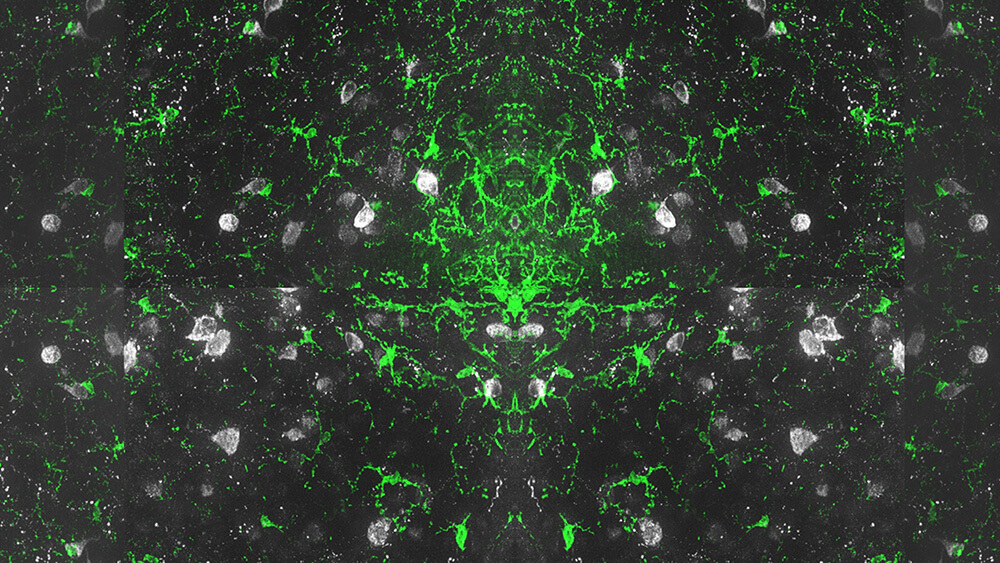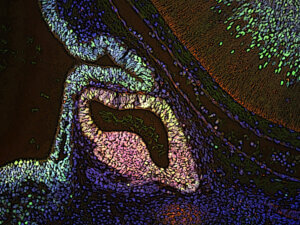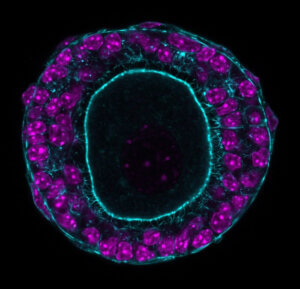
Dr. Anzela Niraula’s grand prize-winning image shows the microglia mandala shows microglia (green) and POMC neurons (grey) within the arcuate nucleus of the hypothalamus in the brain. The regulation of POMC neurons has implications for both obesity and diabetes.
When attendees at ENDO23, the Endocrine Society’s annual meeting on endocrinology research and clinical care, picked up their badges during the June 15-18 event, they were treated to a gallery of works of art — and science — created by their peers. Poster-sized versions of the winning entries in the 2023 Endocrine Images Art Competition lined a wall near the registration desk at Chicago’s McCormick Place Convention Center.
The images, which look like colorful works of other-worldly art, are actually microscopic views of various tissues within a body’s endocrine system. The endocrine system releases hormones into the bloodstream that regulate various functions of the body. The study of this system can help treat conditions including diabetes, obesity, infertility, and hormone-related cancers.

Dr. Sally Camper and her team from the University of Michigan were co-runners-up with this image of a multicolored slice from the pituitary gland of a mouse embryo.
Now in its second year, the Endocrine Images Art Competition drew nearly 30 participants, down from 44 in its inaugural year, Aaron Lohr, the society’s chief communications officer, told Convene. The number of entries reflects the type of research members are conducting, he said, because the images are discovered and generated through their actual work. “None of these images are created especially for the competition,” he said. “They’re just what the scientists see in their everyday work.”
The idea for the competition sprung from the society’s efforts to engage the scientific side of its membership, Lohr said. The Endocrine Society’s “large and diverse membership” is made up of

Dr. Aubrey Converse and a Northwestern University team tied for second place with this image of an ovarian follicle from a mouse.
18,000 scientists and researchers, educators, clinical practitioners, nurse practitioners, and others in health care, he said. More than 7,000 professionals attended ENDO23.
“They all come to the meeting looking for different things,” Lohr said. “We want everyone to feel welcome. We want everyone there to basically celebrate … and elevate their part of the field.”
The 48” x 36” posters near the ENDO23 registration desk not only made the science members feel recognized, he said, but gave all attendees a sense of home in the convention center. “A steady stream of attendees gathered around the posters to get their pictures taken,” he said, adding, “We’ve only gotten very positive feedback from our members.”
Three science members volunteered to judge the entries on two criteria: aesthetics, or beauty, and scientific significance, or as Lohr explained, “Is this something that’s a new and current novel interaction that’s being captured in the image?”
This year’s top winner is a neuroscientist, Anzela Niraula, Ph.D., of the University of Washington in Seattle, who received complimentary registration for ENDO23. The runners-up, teams from the University of Michigan in Ann Arbor and Northwestern University in Chicago, tied for second place. All three winning works were featured in the society’s Endocrine News magazine, a social-media campaign, and at ENDO23. Lohr said the society will hang this year’s winning entries and those from future competitions with last year’s winners on the walls at the society’s headquarters in Washington, D.C.
“Our headquarters will become a gallery of sorts,” he said. “Which is just another way to recognize our members.”
Curt Wagner is digital editor at Convene
